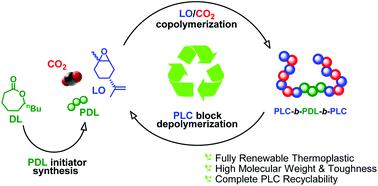当前位置:
X-MOL 学术
›
Green Chem.
›
论文详情
Our official English website, www.x-mol.net, welcomes your
feedback! (Note: you will need to create a separate account there.)
High elasticity, chemically recyclable, thermoplastics from bio-based monomers: carbon dioxide, limonene oxide and ε-decalactone
Green Chemistry ( IF 9.3 ) Pub Date : 2020-11-03 , DOI: 10.1039/d0gc02295k Leticia Peña Carrodeguas 1, 2, 3, 4 , Thomas T. D. Chen 1, 2, 3, 4 , Georgina L. Gregory 1, 2, 3, 4 , Gregory S. Sulley 1, 2, 3, 4 , Charlotte K. Williams 1, 2, 3, 4
Green Chemistry ( IF 9.3 ) Pub Date : 2020-11-03 , DOI: 10.1039/d0gc02295k Leticia Peña Carrodeguas 1, 2, 3, 4 , Thomas T. D. Chen 1, 2, 3, 4 , Georgina L. Gregory 1, 2, 3, 4 , Gregory S. Sulley 1, 2, 3, 4 , Charlotte K. Williams 1, 2, 3, 4
Affiliation

|
One solution to problems with petroleum derived plastics is to design polymers for the circular economy. In this regard, polymer chemistries, like ester or carbonate linkages, which are closer to equilibrium are very promising but to use these materials requires improvements to their properties and methods of manufacture. Here, efficient polymerization catalyses are used to transform wastes and bio-sourced monomers into thermoplastics which combine high elasticity and strength and which can be degraded to allow for some chemical recycling. The plastics are prepared from carbon dioxide, limonene oxide (from waste citrus fruit peel) and ε-decalactone (from triglycerides). These monomers are polymerized, using catalyzed controlled polymerizations with high conversion efficiencies, to selectively form ABA block polymers (A = high Tg polycarbonate, B = low Tg polyester). The series of 5 poly(limonene carbonate)-b-poly(ε-decalactone)-b-poly(limonene carbonate) (PLC-PDL-PLC) samples allow for systematic variations in the overall molar masses (Mn = 50–100 kg mol−1) and hard-block compositions (21–63 wt% PLC). All the polymers are fully characterized using a range of spectroscopies, gel permeation chromatography, thermal and tensile mechanical measurements. The leading plastic combines tensile strength (stress at break, σb = 21.2 MPa, Young's Modulus, Ey = 321 MPa) and high elasticity (elongation at break, εb = 400%) – an enhancement of more than 20× in elongation at break and tensile toughness over poly(limonene carbonate), overcoming the well-known brittleness and processing limitations of PLC. It undergoes selective, catalyzed depolymerization to limonene oxide, carbon dioxide and the precursor polyester providing a future chemical recycling and upcycling opportunity.
中文翻译:

高弹性,化学可循环利用的生物基热塑性塑料,来自二氧化碳,柠檬烯氧化物和ε-癸内酯
解决石油衍生塑料问题的一种方法是设计用于循环经济的聚合物。在这方面,更接近平衡的聚合物化学,例如酯或碳酸酯键是非常有前途的,但是使用这些材料需要改进其性能和制造方法。在这里,有效的聚合催化剂用于将废物和生物来源的单体转化为热塑性塑料,该热塑性塑料具有高弹性和强度,并且可以降解以允许某些化学回收利用。该塑料由二氧化碳,柠檬烯氧化物(来自废柑桔皮)和ε-癸内酯(来自甘油三酸酯)制备。使用具有高转化效率的催化受控聚合法将这些单体聚合,以选择性地形成ABA嵌段聚合物(A =高T g聚碳酸酯,B =低T g聚酯)。5个聚(碳酸柠檬烯酯)-b-聚(ε-癸内酯)-b-聚碳酸柠檬烯酯(PLC-PDL-PLC)系列样品允许系统地改变总摩尔质量(M n = 50-100 kg mol -1)和硬块成分(21-63 wt%PLC)。使用一系列的光谱学,凝胶渗透色谱法,热力学和拉伸力学测量,可以对所有聚合物进行充分表征。领先的塑料联合拉伸强度(断裂应力,σ b = 21.2兆帕,杨氏模量,ê ÿ = 321兆帕)和高弹性(断裂伸长率,ε b = 400%) -断裂超过20×伸长率的提高和拉伸韧性超过聚(苎烯碳酸酯),克服了公知的脆性和加工PLC的限制。它经过选择性催化的解聚反应生成环氧丙烷,二氧化碳和前体聚酯,为将来的化学回收和再利用提供了机会。
更新日期:2020-11-03
中文翻译:

高弹性,化学可循环利用的生物基热塑性塑料,来自二氧化碳,柠檬烯氧化物和ε-癸内酯
解决石油衍生塑料问题的一种方法是设计用于循环经济的聚合物。在这方面,更接近平衡的聚合物化学,例如酯或碳酸酯键是非常有前途的,但是使用这些材料需要改进其性能和制造方法。在这里,有效的聚合催化剂用于将废物和生物来源的单体转化为热塑性塑料,该热塑性塑料具有高弹性和强度,并且可以降解以允许某些化学回收利用。该塑料由二氧化碳,柠檬烯氧化物(来自废柑桔皮)和ε-癸内酯(来自甘油三酸酯)制备。使用具有高转化效率的催化受控聚合法将这些单体聚合,以选择性地形成ABA嵌段聚合物(A =高T g聚碳酸酯,B =低T g聚酯)。5个聚(碳酸柠檬烯酯)-b-聚(ε-癸内酯)-b-聚碳酸柠檬烯酯(PLC-PDL-PLC)系列样品允许系统地改变总摩尔质量(M n = 50-100 kg mol -1)和硬块成分(21-63 wt%PLC)。使用一系列的光谱学,凝胶渗透色谱法,热力学和拉伸力学测量,可以对所有聚合物进行充分表征。领先的塑料联合拉伸强度(断裂应力,σ b = 21.2兆帕,杨氏模量,ê ÿ = 321兆帕)和高弹性(断裂伸长率,ε b = 400%) -断裂超过20×伸长率的提高和拉伸韧性超过聚(苎烯碳酸酯),克服了公知的脆性和加工PLC的限制。它经过选择性催化的解聚反应生成环氧丙烷,二氧化碳和前体聚酯,为将来的化学回收和再利用提供了机会。











































 京公网安备 11010802027423号
京公网安备 11010802027423号